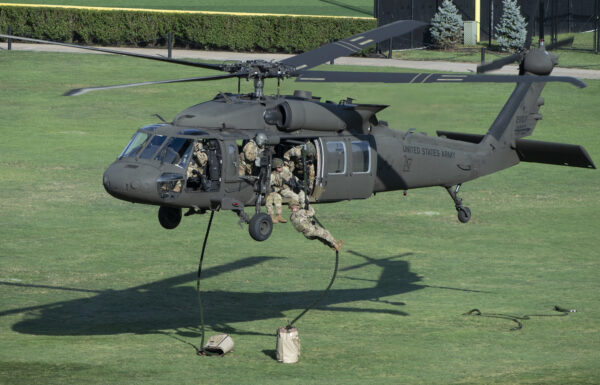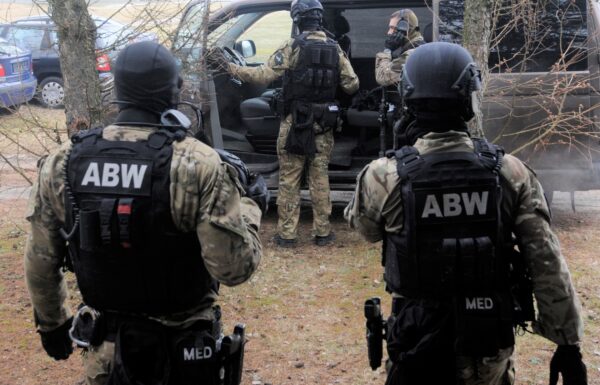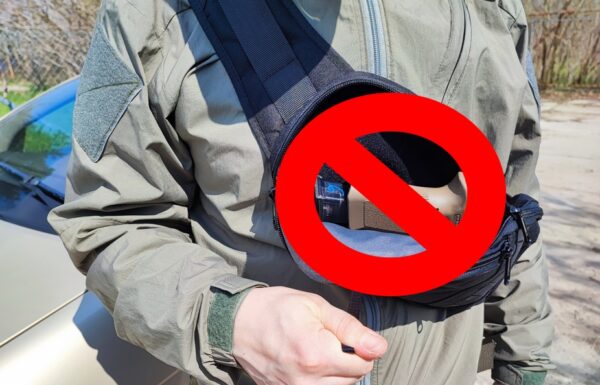ASMTA (Advanced Monitoring of Stand-off Areas) offered by MindMade, a member of WB Group, is an example of such technology. The Polish solution stands out thanks to complex build and scalability. By using seismic sensors and cameras suitable for both day and night operation, the network allows detection and analysis of received signals with the help of proprietary algorithms.
 Photo: Jakub Link-Lenczowski, MILMAG
Photo: Jakub Link-Lenczowski, MILMAG
The technology is based on a network of smart seismic sensors and cameras (normal and thermal) and specialized algorithms that analyze received signals. They operate as a distributed intelligence, meaning that each component works independently of others. Such a solution makes scaling the system to individual users’ demands much easier. Because of that, AMSTA is a modular product with an open architecture. Additional sensors can be connected into the network, and different recognition and defense devices can be synergized with the system. According to notes of the WB Group, the system can be linked with unmanned aerial vehicles (UAV) and security measures such as mines and grenade launchers, capable of slowing down any intruders significantly.
The system can be utilized in two variants. One is stationary, as a permanent element of critical infrastructure’s security (known under the name AMSTA Fence), and the mobile one, designed for construction of impromptu security zones (AMSTA Deploy).
Regardless of the variant used, the system is based on the same component. All elements are linked via two-way wireless communication network. Thanks to the use of distributed intelligence, each element operates independently. Dedicated algorithms are responsible for analysis of signals, recognizing and classifying detected objects. By default, AMSTA detects humans, animals, and vehicles of all types. The open system (self-learning) allows expansion of its databases to cover any unusual objects detected by its sensors.
AMSTA seismic detectors
Seismic sensors are the core of the AMSTA system. The first of them is the Seismic Sensor with GPS (SSG). It is a smart, omnidirectional detector placed in the ground around the borders of the protected zone. It analyzes received seismic waves and classifies them in terms of risk. The signals are compared with the database of vehicles, objects, and living creatures and the sensor passes information about potentially threatening ones. False alarms are not passed further by SSG. According to the manufacturer, it allows for exceptional longevity of the batteries – between 3 months and 4 years (they can also be powered by cable from the 220V power grid). Human activity can be detected approximately 100 meters away from the sensor, while the vehicles can be detected up to 300 meters.
Second type of seismic detector is the Sector Seismic Sensor (SSS). It is a smart, self-learning, omnidirectional detector of a new generation, designed to detect objects moving over the ground. It is placed in the earth and analyzes seismic waves, detects and classifies two classes of objects—”humans” and “vehicles” with the help of proprietary algorithms. After detecting an intrusion, it sends a radio warning that includes the classification and localization of the intruder. Self-learning data processing algorithms and the database of signal signatures reduces the number of false alarms (such as detection of animals).
Observation cameras
When seismic sensors detect a moving object and determine the sector through which it moves, an appropriate camera is activated – working in both day and night modes – to identify the detected object immediately. Like the seismic sensors, the cameras can be placed across the protected zone in permanent positions, such as dedicated masts or constructions present, or spread as needed in temporary locations, such as hanging from trees or set on tripods.
Communication modules are responsible for transmission of data between system components, up to the Stationary Control Station (SSK) that manages the system. Retransmitters can send and receive control signals coming from other elements of the system, such as seismic sensors and cameras. They cooperate with SSK through Ethernet interface, connecting applications of the Stationary Control Station with the remote devices via radio communication; LCS for contacting seismic sensors, and signalization channel for cameras, and DCS for broadband connectivity with cameras.
In regions where classical detectors can’t be used for some reason, AMSTA can operate using microwave or infrared emitters instead. They allow the user to build a microwave “fence” that automatically sends a warning signal when its beams are breached, transmitting location of the breach to the SSK.
Communication
Secure communication between components of the system is enabled by a network composed of two layers: LCS and DCS. Local Communication System (LCS) covers the data transmissions between sensors and effectors. Maximum range of communication in open terrain is up to 2000 meters. Depending on the user’s needs, the LCS network can operate in different frequency bands, including dedicated and special frequencies, ensuring greater reliability and coverage, regardless of the local terrain.
Distant Communication System (DCS) handles the two-way data exchange between LCS, server, and the control station. Its system nodes are linked with each device. DCS uses mobile networks (3G/4G/LTE modems) or dedicated communication channels using frequencies assigned to the specific user (such as military PERAD radio station). All the DCS data transmission is handled through its server.
AMSTA’s ability to cooperate with the PERAD system is a particularly interesting aspect of its modularity. It allows communication with sensors and control stations using dedicated military radio frequencies and ensures transmission of large data packets up to 10 kilometers. In particularly large security zones, the radio signal can be retransmitted, allowing for effective communication in urban and forest areas, and extension of its range to 20 kilometers. PERAD station can be connected directly to the Ethernet port of a computer and can connect to the FONET digital communication platform.
All the information received from sensors goes to the control and monitoring station (SSK) which takes the form of application run on a reinforced laptop, tablet, or stationary device used by the system operator. The application includes modules for dynamic configuration of the system, full supervision over the technical condition of components, analysis of data received from sensors and their following visualization in the form of messages (alarm signals), warnings (intruder identifying icons) on the on-screen map, and video images that verify alarm classification in real time. When the system detects a threat to the protected facility or area, the system dispatcher may decide to take appropriate action. He can send a patrol or a drone to intercept the intruder, he can activate loudspeakers issuing warnings to the trespassers, or he might turn on floodlights, all depending on specific security measures set up within the protected zone. The SSK application has an additional advantage – it can be installed on smartphone-sized handheld devices carried by patrols sent to the place where the alarm was initiated. The device can receive live transmission from local cameras or an unmanned aerial vehicle sent first, providing the patrol with full situational awareness while they neutralize threats to protected objects and areas.
Control station
All the information received from sensors goes to the control and monitoring station (SSK) which takes the form of application run on a reinforced laptop, tablet, or stationary device used by the system operator. The application includes modules for dynamic configuration of the system, full supervision over the technical condition of components, analysis of data received from sensors and their following visualization in the form of messages (alarm signals), warnings (intruder identifying icons) on the on-screen map, and video images that verify alarm classification in real time. When the system detects a threat to the protected facility or area, the system dispatcher may decide to take appropriate action. He can send a patrol or a drone to intercept the intruder, he can activate loudspeakers issuing warnings to the trespassers, or he might turn on floodlights, all depending on specific security measures set up within the protected zone. The SSK application has an additional advantage – it can be installed on smartphone-sized handheld devices carried by patrols sent to the place where the alarm was initiated. The device can receive live transmission from local cameras or an unmanned aerial vehicle sent first, providing the patrol with full situational awareness while they neutralize threats to protected objects and areas.
Using AMSTA system
AMSTA presents a new standard of quality for securing key objects and areas. The war in Ukraine, and the prior crisis on Polish-Belarusian border clearly showed the importance of automated perimeter security systems. Protection of military compounds, airfields, and key industrial plants requires engaging a significant number of resources and staff. Automation offered by MindMade’s product quickens and streamlines the security protocols.
Significantly, AMSTA is compatible with military communication systems, enabling its implementation into the future combat field management applications. Today, the WB Group system is already used to protect eastern border of the European Union.




































